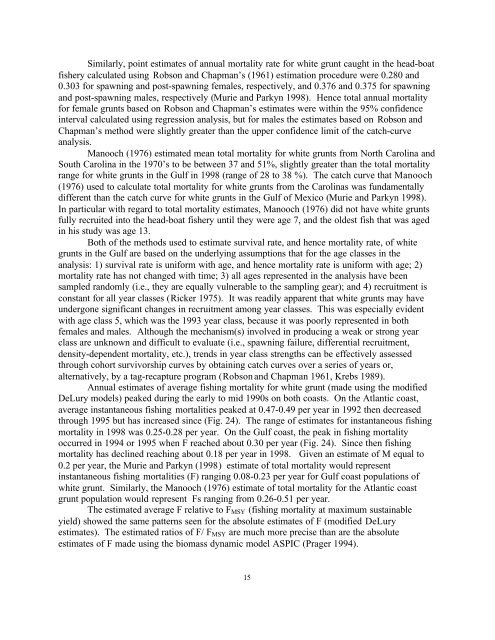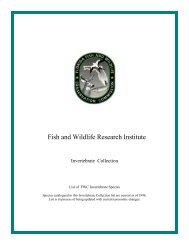STOCK ASSESSMENT OF WHITE GRUNT FROM THE WEST ...
STOCK ASSESSMENT OF WHITE GRUNT FROM THE WEST ...
STOCK ASSESSMENT OF WHITE GRUNT FROM THE WEST ...
You also want an ePaper? Increase the reach of your titles
YUMPU automatically turns print PDFs into web optimized ePapers that Google loves.
Similarly, point estimates of annual mortality rate for white grunt caught in the head-boat<br />
fishery calculated using Robson and Chapman’s (1961) estimation procedure were 0.280 and<br />
0.303 for spawning and post-spawning females, respectively, and 0.376 and 0.375 for spawning<br />
and post-spawning males, respectively (Murie and Parkyn 1998). Hence total annual mortality<br />
for female grunts based on Robson and Chapman’s estimates were within the 95% confidence<br />
interval calculated using regression analysis, but for males the estimates based on Robson and<br />
Chapman’s method were slightly greater than the upper confidence limit of the catch-curve<br />
analysis.<br />
Manooch (1976) estimated mean total mortality for white grunts from North Carolina and<br />
South Carolina in the 1970’s to be between 37 and 51%, slightly greater than the total mortality<br />
range for white grunts in the Gulf in 1998 (range of 28 to 38 %). The catch curve that Manooch<br />
(1976) used to calculate total mortality for white grunts from the Carolinas was fundamentally<br />
different than the catch curve for white grunts in the Gulf of Mexico (Murie and Parkyn 1998).<br />
In particular with regard to total mortality estimates, Manooch (1976) did not have white grunts<br />
fully recruited into the head-boat fishery until they were age 7, and the oldest fish that was aged<br />
in his study was age 13.<br />
Both of the methods used to estimate survival rate, and hence mortality rate, of white<br />
grunts in the Gulf are based on the underlying assumptions that for the age classes in the<br />
analysis: 1) survival rate is uniform with age, and hence mortality rate is uniform with age; 2)<br />
mortality rate has not changed with time; 3) all ages represented in the analysis have been<br />
sampled randomly (i.e., they are equally vulnerable to the sampling gear); and 4) recruitment is<br />
constant for all year classes (Ricker 1975). It was readily apparent that white grunts may have<br />
undergone significant changes in recruitment among year classes. This was especially evident<br />
with age class 5, which was the 1993 year class, because it was poorly represented in both<br />
females and males. Although the mechanism(s) involved in producing a weak or strong year<br />
class are unknown and difficult to evaluate (i.e., spawning failure, differential recruitment,<br />
density-dependent mortality, etc.), trends in year class strengths can be effectively assessed<br />
through cohort survivorship curves by obtaining catch curves over a series of years or,<br />
alternatively, by a tag-recapture program (Robson and Chapman 1961, Krebs 1989).<br />
Annual estimates of average fishing mortality for white grunt (made using the modified<br />
DeLury models) peaked during the early to mid 1990s on both coasts. On the Atlantic coast,<br />
average instantaneous fishing mortalities peaked at 0.47-0.49 per year in 1992 then decreased<br />
through 1995 but has increased since (Fig. 24). The range of estimates for instantaneous fishing<br />
mortality in 1998 was 0.25-0.28 per year. On the Gulf coast, the peak in fishing mortality<br />
occurred in 1994 or 1995 when F reached about 0.30 per year (Fig. 24). Since then fishing<br />
mortality has declined reaching about 0.18 per year in 1998. Given an estimate of M equal to<br />
0.2 per year, the Murie and Parkyn (1998) estimate of total mortality would represent<br />
instantaneous fishing mortalities (F) ranging 0.08-0.23 per year for Gulf coast populations of<br />
white grunt. Similarly, the Manooch (1976) estimate of total mortality for the Atlantic coast<br />
grunt population would represent Fs ranging from 0.26-0.51 per year.<br />
The estimated average F relative to F MSY (fishing mortality at maximum sustainable<br />
yield) showed the same patterns seen for the absolute estimates of F (modified DeLury<br />
estimates). The estimated ratios of F/ F MSY are much more precise than are the absolute<br />
estimates of F made using the biomass dynamic model ASPIC (Prager 1994).<br />
15




